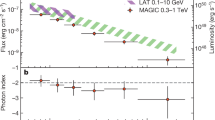Abstract
Most γ-ray bursts are thought to originate from or near the surface of neutron stars1. Their spectra, however, have been measured only in the 30 keV–10 MeV energy range2, with possible detection of some 1–12 keV X rays reported for several events3 (notably the Apollo event of 27 April 1972)4 at a level ≃0.01–0.02 of the γ-ray flux. Here I propose that γ-ray bursters may also strongly emit 0.05–1 keV XUV radiation simultaneously with the γ-rays, in the form of two narrow spectral lines, corresponding to the ωe and 2ωe plasma radiation, where ωe = (4πnee2/me)1/2 is the electron plasma frequency of the γ- emitting (and pair annihilation) region of the burster. As estimates based on observed annihilation line intensities and other theoretical arguments typi cally give ne≳1024–1026 cm−3 (ref. 5), hωe≳37–373 eV, in the XUV range. If detected and their frequencies accurately measured with high time resolution, such radiation could be a valuable diagnostic tool for the emission region, as in the case of solar radio bursts6. Failure to detect them would also put strong con-traints on the γ-emission models.
This is a preview of subscription content, access via your institution
Access options
Subscribe to this journal
Receive 51 print issues and online access
$199.00 per year
only $3.90 per issue
Buy this article
- Purchase on Springer Link
- Instant access to full article PDF
Prices may be subject to local taxes which are calculated during checkout
Similar content being viewed by others
References
Lamb, D. Ann. N.Y. Acad. Sci. (in the press).
Hurley, K. AIP Conf. Proc. Santa Cruz Summer Workshop (ed. Woosley, S.) (AIP, New York, 1984).
Laros, J. G. et al. AIP Conf. Proc. Santa Cruz Summer Workshop (ed. Woosley, S.) (AIP, New York, 1984).
Gilman, D. et al. Astrophys. J. 236, 951–957 (1980).
Liang, E. P. AIP Conf. Proc. No. 101, (eds Burns, M. L., Harding, A. K. & Ramaty, R.) 76 (AIP, New York, 1983).
Kundu, M. Solar Radio Astronomy (Reidel, Dordrecht, 1980).
Boyd, T. J. M. & Sanderson, J. J. Plasma Dynamics (Barnes & Noble, New York, 1969).
Bekefi, G. Radiation Processes in Plasmas, (Wiley, New York, 1966).
Tidman, D. A. & Dupree, T. H. Phys. Fluid 8, 1860–1870 (1965).
Tidman, D. A. Planetary Space Sci. 13, 781–788 (1965).
Mazets, E. P. et al. AIP Conf. Proc. No. 101 (eds Burns, M. L., Harding, A. K. & Ramaty, R.) 36 (AIP, New York, 1983).
Fenimore, E. E. et al. COSPAR Symp. Proc. Ottawa (1982).
Golenetskii, S. V. et al. Nature 307, 41–42 (1984).
Terrell, J. et al. Astrophys. J. 254, 279–286 (1982).
Liang, E. P. Astrophys. J. Lett. 283, 421–423 (1984).
Liang, E. P. & Antiochos, S. Nature 310, 121–122 (1984).
Rothschild, R. E. & Lingenfelter, R. E. Nature 312, 737–740 (1984).
Author information
Authors and Affiliations
Rights and permissions
About this article
Cite this article
Liang, E. Plasma radiation during γ-ray bursts. Nature 313, 202–204 (1985). https://doi.org/10.1038/313202a0
Received:
Accepted:
Issue Date:
DOI: https://doi.org/10.1038/313202a0
This article is cited by
-
A flare-induced cascade model of γ-ray bursts
Nature (1986)
Comments
By submitting a comment you agree to abide by our Terms and Community Guidelines. If you find something abusive or that does not comply with our terms or guidelines please flag it as inappropriate.



